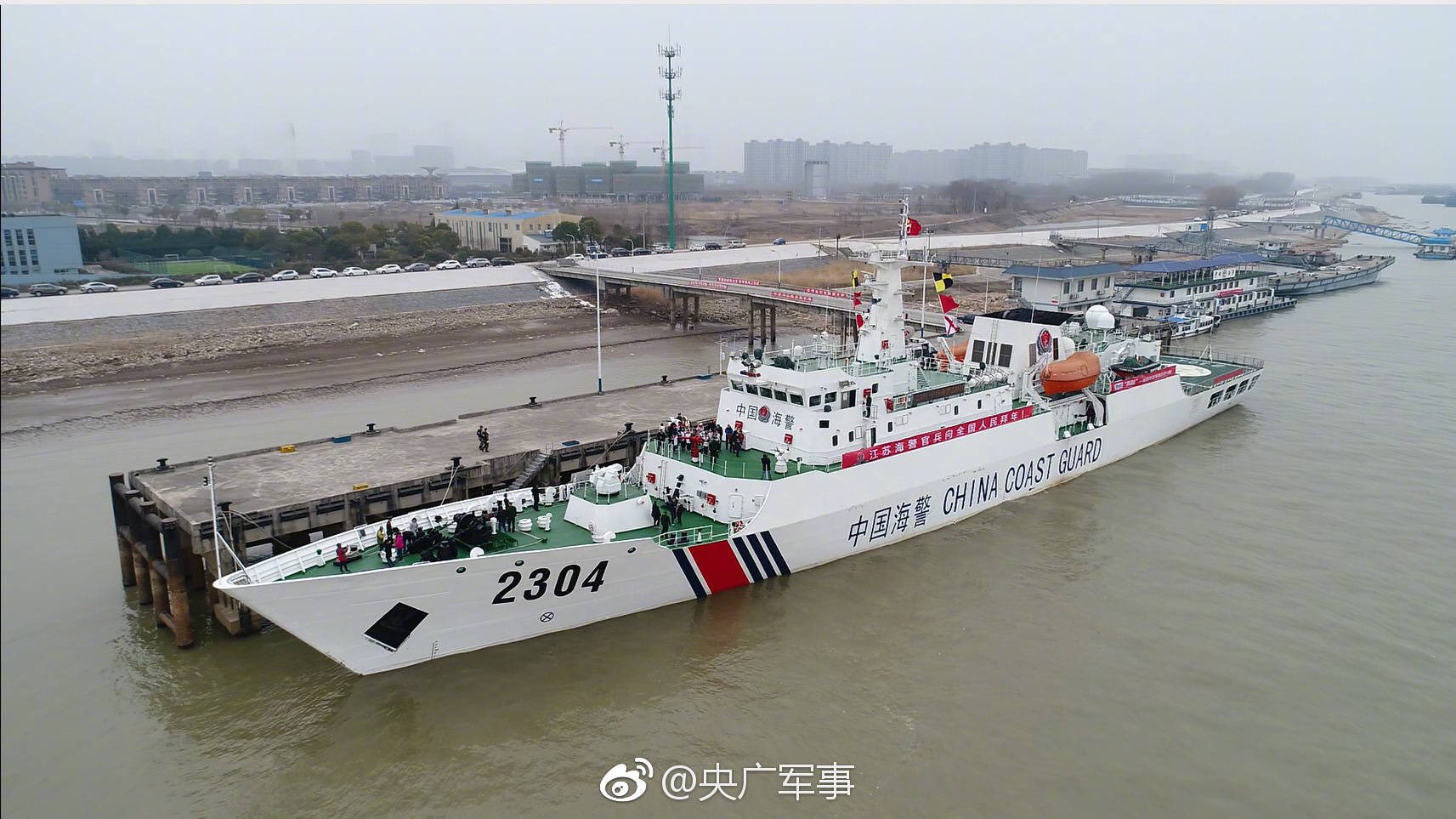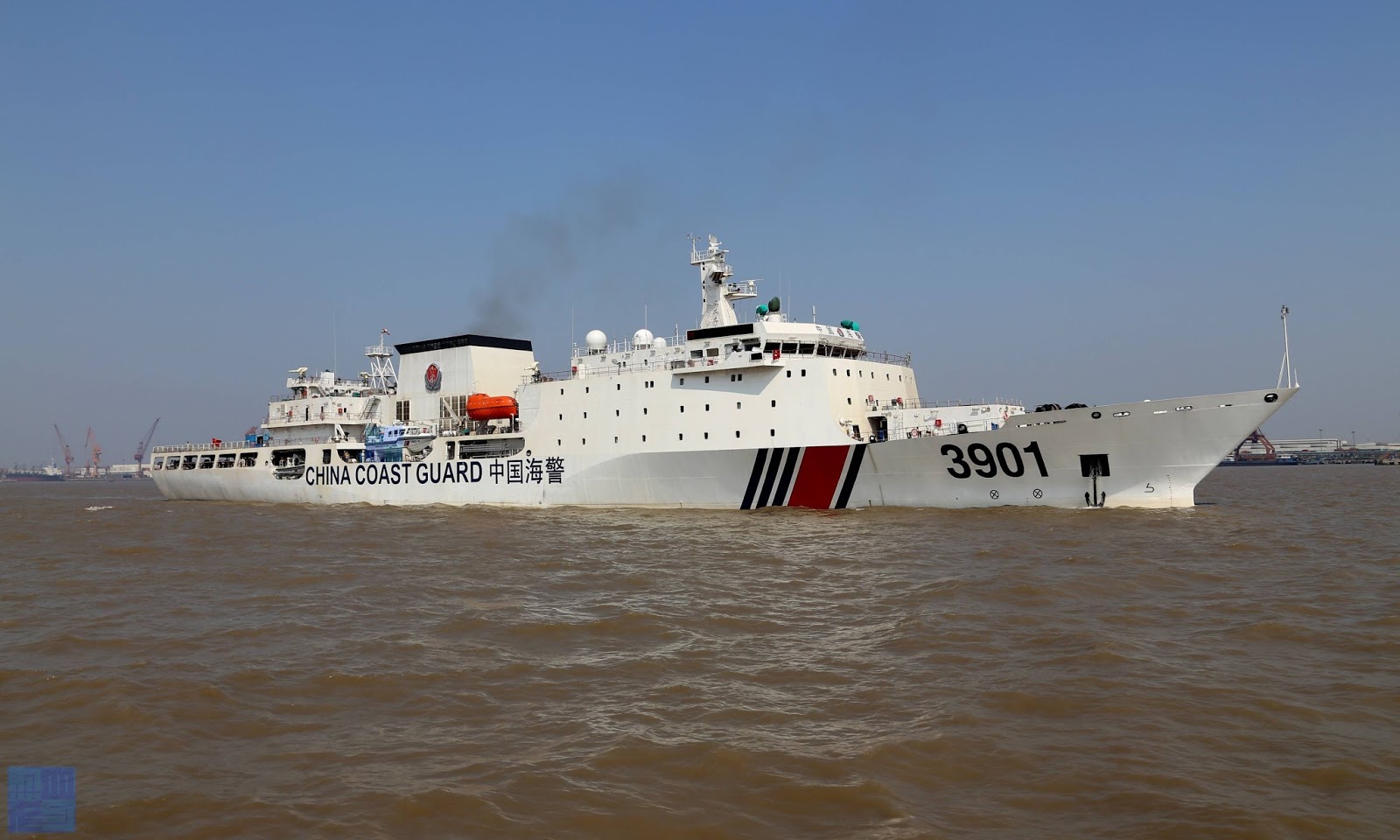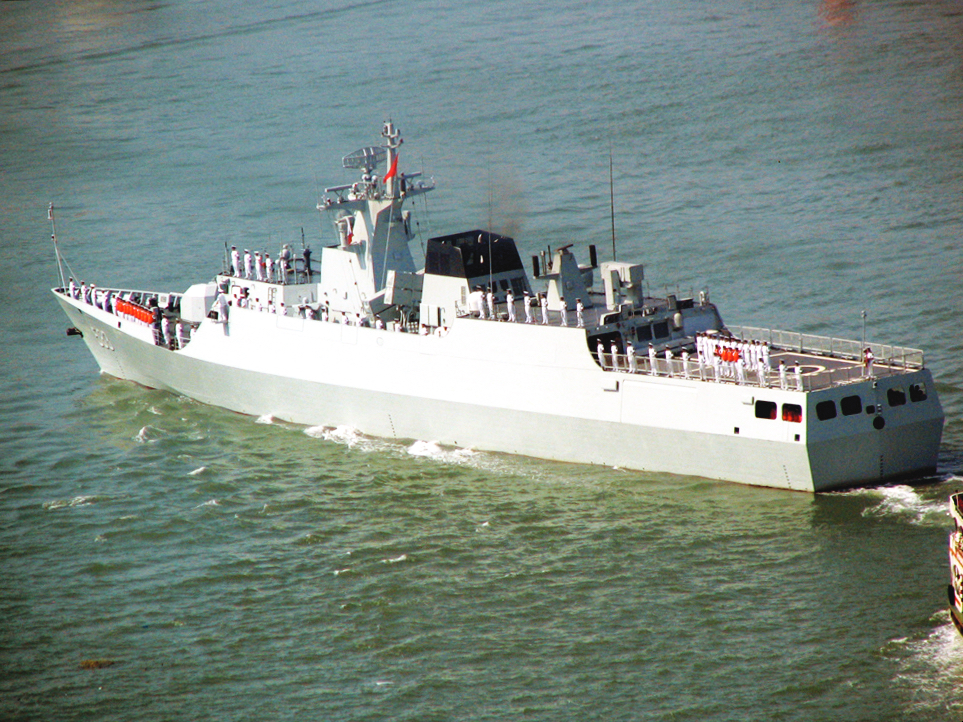
It appears that the China Coast Guard could have reached its limit in terms of size and utility.
Within the space of a decade the China Coast Guard (CCG) has become the largest coast guard force in the world. It was created by unifying five different maritime constabulary forces and allocated a huge number of assets of different sizes and supported by large amounts of funding. Since then the CCG has made its presence felt particularly in the contested waters of the East and South China Seas in the first island chain where it supports Beijing’s claims to maritime territory within its long-held ‘nine-dash line’ policy.
However, despite creating heightened tensions at sea by disrupting naval operations, fishing, oil exploration and drilling activities of states in the South China Sea and regularly encroaching on the maritime territory of Japan’s Senkaku Islands in the East China Sea, the CCG may have reached the peak of its power but with little to show for it. The pressure the CCG has exerted on its neighbours has not resulted in any specific gains for Beijing in terms of securing its maritime claims and arguably has only galvanised opposition to China.

The CCG was created in 2013 through the amalgamation of the China Maritime Police Bureau, China Maritime Surveillance, Fisheries Law Enforcement Command and the Anti-Smuggling Bureau, blending them into a more overtly paramilitary organisation. China’s Maritime Safety Agency however was left out due to its less paramilitary nature focussing on traditional coast guard activities including ship safety and maritime navigation and infrastructure.
This unification of agencies saw the transfer of existing assets and personnel into the CCG, which wanted to operate more like other coast guard forces, such as the US Coast Guard, as a primary constabulary force operating further out from its coastal waters and littorals. However, the CCG has an additional unique mission known as ‘right enforcement operations’ whereby it goes out into disputed waters, maintains a visible presence, tries to enforce Chinese domestic law and contests the efforts by other states to administer those waters.

CCG inventory
To better support this mission the CCG has been given a large inventory of ships, either transferred from the People’s Liberation Army Navy (PLAN) or built new specifically for the task of coercion. The US DoD’s China Military Power Report in 2022 cited the 2021 transfer of 22 Type 056 Jiangdao-class corvettes from the PLAN to the CCG as an example of military platforms crossing jurisdictions.
The report also cited a US Naval War College study from 2019 that estimated that the CCG operates over 140 oceangoing patrol vessels of more than 900 tonnes displacement, over 120 patrol combatants ranging from 450-900 tonnes and about 450 coastal patrol craft of 90-450 tonnes.
The report said that the new purpose-built ships are larger and include helicopter facilities, water cannon, interceptor boats, and are fitted with guns from 20-76mm. An example is the Zhaotao-class cutters – two 165m-long 10,000 tonne ships that entered CCG service in 2015 and are the largest coast guard vessels in the world. Meanwhile of the 10 new classes of CCG ship that have entered service the CCG’s six new 3,600 tonne Zhaoduan-class (Type 818) introduced in 2016-17 are based on the PLAN’s Type 054A (Jiangkai II-class) frigates and its three 1,500 tonne Zhaogao-class cutters delivered in 2015-16 are based on the Type 056 corvettes.

Gregory Poling, senior fellow for Southeast Asia and director of the Asia Maritime Transparency Initiative at the Center for Security and International Studies, told AMR that the CCG is commanded by sailors not civilians and the most capable vessels in the CCG are former PLAN ships that have been “painted white”. He added that the newer ships look “indistinguishable from naval ships” right down to the inclusion of 76mm guns and that “they clearly are a militarised force.”
Poling said that the reason the CCG was able to secure so much funding and new prerogatives from the Chinese government is because the concepts of maritime rights protection “has been at the core of Xi Xinping’s political programme since he was elevated to the presidency.” President Xi’s first ‘China dream’ speech in 2013 featured a big component about China’s rise as a maritime power and the re-taking of lost maritime territory and the CCG was created for this purpose.
The paramilitary nature of the CCG was solidified in 2018 when control of the organisation was passed from the civilian administration in the Ministry of Public Security and State Oceanic Administration to military administrators in the Central Military Commission (CMC) through the People’s Armed Police (PAP). The PAP is responsible for internal security, maritime security and supports the People’s Liberation Army (PLA) during conflict.
This is significant because Beijing views the maritime areas and islands it is claiming under the nine-dash line as its own territory and therefore an internal security problem. This was reinforced by China’s 2021 Coast Guard Law that authorised the use of weapons by the CCG against vessels in specific circumstances that Beijing says are in waters under Chinese jurisdiction. It also gives the CCG permission to destroy buildings, structures and floating devices from foreign organisations.
The DoD’s China Military Power Report also highlights the growing interoperability and integration between the PLAN, CCG and the People’s Armed Forces Maritime Militia (PAFMM). It said that PAFMM units are “often used to supplement CCG cutters at the forefront of the incident, giving the Chinese the capacity to outweigh and outlast rival claimants.” Although the PAFMM personnel are marine industry personnel or fisherman they are often trained by the PLAN or CCG and are ready to respond when called upon.
The CCG is divided into three regional commands – the North, East and South Sea – with commanders that have all previously served in the PLAN. It is believed that the PLA’s Theatre Commands likely commands all the CCG and PAFMM forces during operations. For example, the Eastern Theatre Command would be in charge of all maritime assets in operations against Japan’s Senkaku islands. In January 2021 Japan protested against CCG patrols in the territorial sea of the islands that lasted for more than 100 consecutive days with another incident in August that year involving seven CCG ships.

SCS island patrol
This situation is similar in the south where the CCG command is subordinated to the PLA’s Southern Theatre Command. The PLA deploys a mix of PLAN, CCG and PAFMM assets into the South China Sea and since 2018, when China completed the construction of a series of artificial islands, it has been able to maintain a more consistent presence around disputed areas using facilities to forward support its vessels.
Disputed areas in the SCS include the Second Thomas Shoal in the Spratley Islands, where the Philippines operates a Philippines Marine Corp station on the grounded supply ship BRP Sierra Madre; the Whitsun Reef, Scarborough Shoal, and at Reed Bank where the Philippines is investigating oil exploration.
The CCG has also been patrolling near Vietnam’s Nam Con Son oil drilling project in the Vanguard Bank and contesting Vietnam’s claims to the Paracel Islands. Meanwhile Malaysia has seen Chinese activity around the Luconia Shoals and in 2021 Indonesia experienced four months of CCG and PLAN patrols around its drilling operations in the Tuna Block oil field in the North Natuna Sea.
In the early years of the CCG’s operations its missions were classed as non-naval ‘grey zone’ activities. However, Poling said that since the CCG’s incorporation into the CMC structure in 2018, its joint training and exercises with the PLAN, the offensive rights protection operations, placement of senior naval officials in the top brass of the CCG and former PLAN ships used in CCG service, it means that the line between the two “is getting more and more blurred.”

“… the CCG is not really a coast guard, just a navy with a different paint job…”
He explained that increasingly other states are treating the CCG “more or less as China’s second navy. The normative cover that China had by deploying the CCG instead of the PLAN has been chipped away.” Poling added: “It still works, to a degree, but there is a sense in the region and with outside parties like the US that the CCG is not really a coast guard, just a navy with a different paint job – and that may well diminish its value in the grey zone over time.”
The way that countries in East and South East Asia are responding to China’s incursions and disruptive actions are changing as a result. Countries are making it clear that the CCG is being judged more on its behaviour and actions rather than the whether the ship is white or grey in colour. It means if the CCG poses a threat to safety at sea or carries out an act of aggression then it could have a wider impact, for example triggering US-Philippine mutual defence obligations, as if they were PLAN ships.
“Mostly it is a matter of shifting rules of engagement and changing the messaging around deterrence,” Poling said. He explained that unlike the PAFMM, which can more legitimately operate in the grey zone and attribution of its activities to state authorities is difficult, “the CCG does not have that veneer of deniability, anything they do they were ordered to do it.”
However, the CCG still has some key differences with the PLAN. The CCG operates both militarily and in constabulary operations, it is the prime interface with the PAFMM and it is the first choice for deployment in most law enforcement operations. When harassing oil and gas drilling operations, the CCG will be deployed rather than the PLAN, however if violence escalated it is clear the CCG would become another type of naval force.
It is rare for the CCG to operate outside the first island chain or conduct the kind of defence diplomacy missions that are part of other coast guard mission sets. The US Coast Guard deploys outside of US waters for joint training or exercises helping to build up partner capacity, or for operations in partnership with other nations under specific agreements using USCG vessels with foreign nation components on board to help enforce their laws. Poling said for the CCG to conduct this kind of operation “you would have to imagine a degree of strategic trust in China that basically nobody has.”
He believes that the future for the CCG “is a little unclear” because although it has enormous capacity – even over capacity – for its missions, “it seems like they have reached the limits of what grey zone coercion can accomplish.”
Risky behaviour
Poling said that even since early 2022 the ability of Vietnam, Indonesia and Malaysia to engage in oil drilling operations has not been prevented, despite daily CCG harassment. The Philippines Navy and Philippines Coast Guard have been able to resupply BRP Sierra Madre in the Second Thomas Shoal, despite close encounters between their ships and those of the CCG.

However, he added that although SE Asian countries have found a discreet number of strategically important places where they’re holding the ground, as this happens more frequently situations could get “pretty dangerous” because a lot of the CCG behaviour “relies on intentionally created risk collision” between ships and there could be “accidental escalation.”
Beijing has created this behemoth and without the possibility of achieving any further goals other than continuing to try and harass its neighbours it is likely that the construction of new CCG ships will be reduced and a slowdown in the numbers of ships transferred from the PLAN. However, this is likely to be difficult in the short-term considering that the new ships have all be built and brought into service less than 10 years ago.
Poling said it is more likely that the size of the PAFMM is likely to contract because similar to the CCG it also is unable to deliver much additional benefits. “Beijing will have to recalibrate leaning more heavily on the CCG and PLAN to settle in for a very long-term stand-off in which nobody is going to blink – and it is impossible to change the status quo any further without military force, which China still seems reluctant to use,” he said.
It seems clear that when China embarked on its coercion campaign Beijing thought that Japan, Vietnam, Malaysia, Indonesia and the Philippines, would all back down especially considering a narrative of American decline after the 2008 financial crisis and pre-occupation with counter-insurgency in the Middle East. But even though China has been successful with its island building campaign, with re-energised US backing and support from other countries internationally, Japan and the SCS claimant countries have been able to stand their ground and are improving their capabilities to respond.
Reductions in force structures may happen in the medium-to-long term if China decides to divert resources elsewhere. In the meantime, with these considerable assets at its disposal and an entire industry of shipbuilding (some 20 naval and commercial shipyards) and personnel built up to deliver coercion in the East and South China Sea, Beijing can be expected to continue its policy of brinkmanship, making every interaction more dangerous and a possible trigger for conflict.
by Tim Fish












